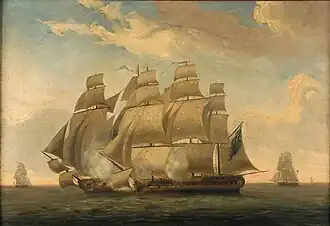French frigate Sibylle (1777)
 Sibylle (left) at the action of 2 January 1783
| |
| History | |
|---|---|
| Name | Sibylle |
| Builder | Brest. Plans by Jacques-Noël Sané [1] |
| Laid down | April 1777 [1] |
| Launched | 1 September 1777 [1] |
| Commissioned | November 1777 [1] |
| Fate | Captured by the British Royal Navy in 1783 and broken up in 1784 |
| General characteristics [1] | |
| Class & type | Sybille-class |
| Tons burthen | 600 tonnes |
| Length | 43.8 metres |
| Beam | 11.2 metres |
| Draught | 5.4 metres |
| Propulsion | Sail |
| Complement | 260 |
| Armament |
|
| Armour | Timber |
Sibylle was a 32-gun copper-hulled, frigate of the French Navy, lead ship of her class.
Career
Sibylle took part in the Battle of Ushant on 27 July 1778, under Sébastien Mahé de Kerhouan.[1][2] She was part of the division under Toussaint-Guillaume Picquet de la Motte that captured 18 British merchantmen in the action of 2 May 1781.[1]
In 1783, Sibylle was under Captain Théobald René de Kergariou-Locmaria. On 2 January, she fought a hotly contested, and ultimately inconclusive action of 2 January 1783 against HMS Magicienne.[1]
Sibylle effected repairs and returned to the sea, but ended up being captured by HMS Centurion and Hussar in the action of 22 January 1783.[1]
Fate
The British broke up Sibylle in 1784.[1]
Citations
References
- Contenson, Ludovic (1934). La Société des Cincinnati de France et la guerre d'Amérique (1778-1783). Paris: éditions Auguste Picard. OCLC 7842336.
- Roche, Jean-Michel (2005). Dictionnaire des bâtiments de la flotte de guerre française de Colbert à nos jours, 1671 - 1870. Group Retozel-Maury Millau. pp. 325–6. ISBN 978-2-9525917-0-6. OCLC 165892922.